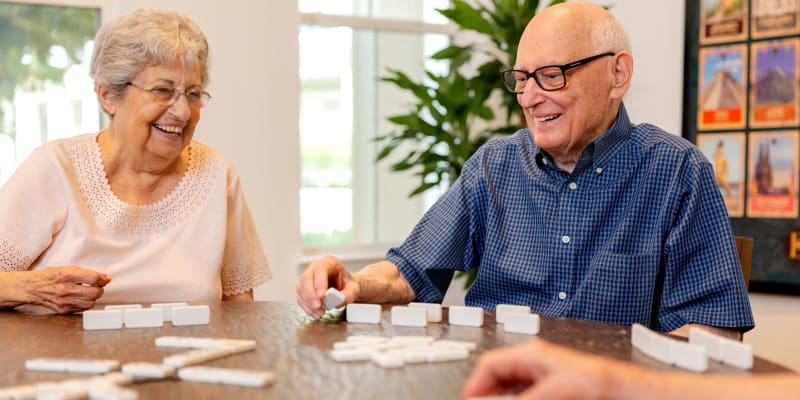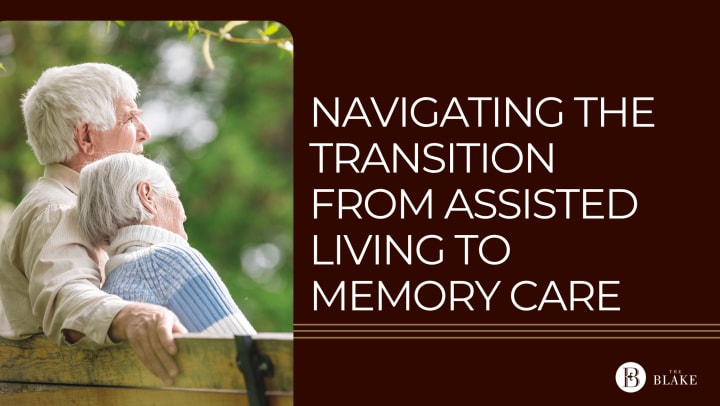Transitioning a loved one from assisted living to memory care can be an overwhelming decision. At The Blake, we understand the challenges that families face during this process and provide the necessary resources and support to make the transition as smooth as possible. With our "age in place" approach, we offer both assisted living and memory care communities at all our properties. In this blog, we'll discuss the signs indicating that it might be time for this transition, offer helpful resources, and provide practical tips to help ease the journey.
Recognizing the Signs:
Knowing which signs to look out for is a good place to start. Here are some common signs that you may begin to recognize in your loved one leading up to deciding:
1. Change in Behavior: Noticeable shifts in behavior, such as increased agitation, aggression, or withdrawal, can be indicators of worsening cognitive decline.
2. Trouble Navigating Surroundings: Difficulty finding their way around familiar places or becoming easily disoriented may signal the need for more specialized care.
3. Lack of Problem-Solving Skills: Individuals may struggle with solving even simple problems, like managing their medications or handling everyday tasks. This may hint that it may be time to transition from assisted living to memory care.
4. Loss of Interest in Activities: A lack of interest in hobbies and activities they once enjoyed may suggest cognitive decline. This can also include self-isolation tendencies and not participating in group activities.
5. Poor Hygienic Habits: Neglecting personal hygiene or forgetting to bathe and groom themselves can also be signs of cognitive impairment.
6. Wandering: Wandering aimlessly without regard for safety can be dangerous in an assisted living setting and may point toward the need for transition into memory care.
Helpful Resources and Tips:
Once you feel that a transition may be best for your loved one, you may be looking for additional resources to help aid the process. Here we have compiled a few resources and practical tips that may be useful:
1. "Creating Moments of Joy" by Jolene Brackey: This book offers insights into creating positive and engaging experiences for individuals with dementia, helping enhance their quality of life. The book is broken down into multiple sections with different steps and tips to help guide family and friends dealing with a loved one with a memory impairment.
2. Family Support Groups: Joining a support group can provide you with emotional support, valuable advice, and a sense of community with others facing similar challenges. Many of our communities host family support groups monthly. For more information about joining, please contact the community directly.
3. Personalizing Their New Space: Personalize their belongings and pack items that will bring comfort and familiarity to their new environment. Try to create a strong sense of home when decorating. Find items that bring them joy and spark good memories.
4. Communication: Engage in open and honest conversations with your loved one about the transition. Acknowledge their concerns and answer their questions patiently.
5. Encourage Participation: Encourage your loved one to take part in activities during the move; this will help them adjust to their new surroundings and routine. It can also help take the burden and stress of moving off your loved one and encourage making friends and participating in activities early on.
6. Stay with Them Initially: If possible, spend the first night and the following day with your loved one in their new environment to provide comfort and reassurance.
7. Focus on Positives: Emphasize the positive aspects of memory care, such as specialized care, safety, and activities tailored to their needs. Try to keep the mood light and uplifting, as this may help make for a calmer and easier transition.
Transitioning from assisted living to memory care is a significant step in the journey of caring for a loved one with dementia. Recognizing the signs, accessing helpful resources, and following practical steps can make this transition smoother and less daunting for both you and your loved one. At The Blake, we are here to support you every step of the way, ensuring the best possible care and quality of life for your family member. If you ever have any questions, please reach out; we are here to help in any way that we can.










